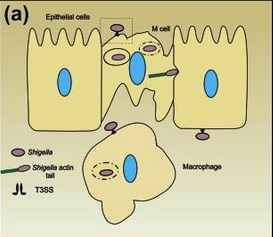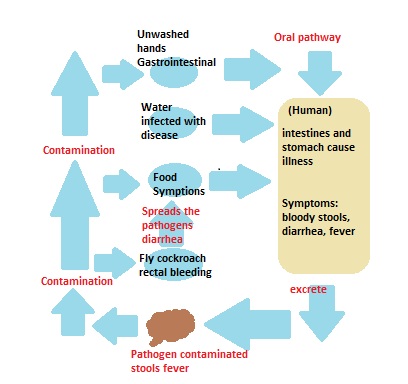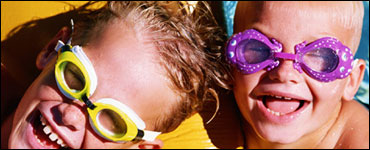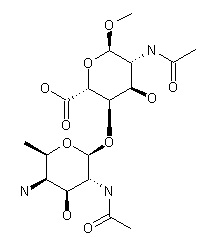Interactions
How it interacts with human body
cells
Shigella sonnei exhibits a parasitic relationship with
its human host. This bacterial infection is characterized by the
invasion of intestinal mucosa. This infection stays in colon and
rectal
mucosa of a human where
 the bacteria cause inflammatory
destruction of the mucosal wall. It only takes a minimum of ten
bacteria to cause this clinical infection called
shigellosis.
the bacteria cause inflammatory
destruction of the mucosal wall. It only takes a minimum of ten
bacteria to cause this clinical infection called
shigellosis.
Shigella sonnei along with all other types of Shigella, cause inflammatory response to the
enteric cell wall and cell death to the
colonic epithelium. After the cell death in the colonic
epithelium, the cells release all their intra-cellular content. The
human immune system then tries to clean up the mess but this causes
an enteric inflammatory response that contributes to the shigellosis
infection.
Once Shigella sonnei enters the
colonic cells wall, the bacteria can spread to other cells in the
intestinal tract. Once this bacterial infection is inside the
intestinal tract, Shigella enters into the epithelial cell’s
cytoplasm where more new cells are made and then these cells move to
invade other cells. When the Shigella cells multiple in the
epithelial cell, they cause mucosal ulceration, inflammation, and
bleeding. The most common symptoms of Shigella sonnei is
bloody stool and small to severe diarrhea. The other occasional
symptoms of some people are the constant feeling of having to e mpty
the bowel, pain, cramping, fever, nausea, and vomiting. In some
young children, seizures may also occur.
mpty
the bowel, pain, cramping, fever, nausea, and vomiting. In some
young children, seizures may also occur.
There is a bacteriophage or formally called phage, that inhibits
Shigella sonnei. A phage or bacteriophage is a virus that
infects and then replicates inside bacteria. The phage that
infects Shigella sonnei is EP23. This phage also infects E.
coli.
Other Organisms that live in
intestine
Other organisms that live in the intestinal tract of humans are
yeasts
such as
Lactobacillus acidophilus and
Lactobacillus
bulgaricus. There are also hundreds of types of
bacteria such as
Escherichia coli,
Staphylococcus, and
Clostridium difficile Also, there are many other parasitic
organisms that live in the intestinal tract such as
amoebas,
Giardia lamblia,
tapeworms, and
Trichina worms.
How it enters the body
Shigella sonnei can enter the body from many different
ways. First, it can be transferred from water borne infection that a
person comes in contact with and gets ingested into their system.
Another way this bacterial infection enters the human body is
through fecal-oral contact where someone who is infected comes in
contact with meat or any type of food and it is transmitted to the
people who consume it. Yet another way is just the interaction between people
or objects that the infected person has touched if that person was
not being sanitary. It all comes down to the fecal-oral contact that
transmits Shigella sonnei but there
are numerous ways this can happen without even being aware. The
diagram above shows the different ways that a person can come in
contact with the bacterial infection.
consume it. Yet another way is just the interaction between people
or objects that the infected person has touched if that person was
not being sanitary. It all comes down to the fecal-oral contact that
transmits Shigella sonnei but there
are numerous ways this can happen without even being aware. The
diagram above shows the different ways that a person can come in
contact with the bacterial infection.
Chemical Structure
 The
diagram to the right is the chemical structure of Shigella
sonnei. This structure is bonded with all nitrogen and
oxygen which require both single and double bonds. Shigella
sonnei uses the Gram-negative pathogen's Type III secretion
system as a mechanism of invasion. The Type III secretion system
is where a needle-like structure is used to find eukaryotic
organisms and disperse proteins to help the bacteria infect the
host. The proteins are secreted from the Shigella sonnei
cell directly into a eukaryotic cell. These proteins are called
Invasion Plasmid Antigen proteins.
The
diagram to the right is the chemical structure of Shigella
sonnei. This structure is bonded with all nitrogen and
oxygen which require both single and double bonds. Shigella
sonnei uses the Gram-negative pathogen's Type III secretion
system as a mechanism of invasion. The Type III secretion system
is where a needle-like structure is used to find eukaryotic
organisms and disperse proteins to help the bacteria infect the
host. The proteins are secreted from the Shigella sonnei
cell directly into a eukaryotic cell. These proteins are called
Invasion Plasmid Antigen proteins.
Now that you know the ways this bacterial infection interacts with
your body, it is time to check out the facts of Shigella!
GO!
